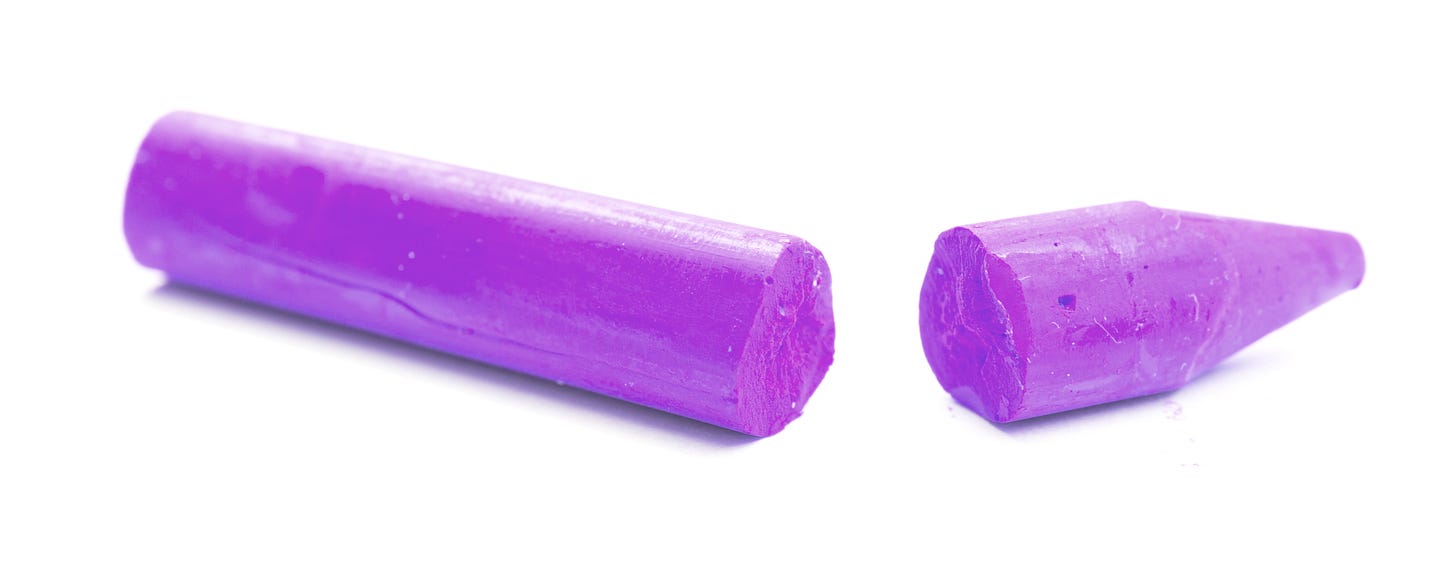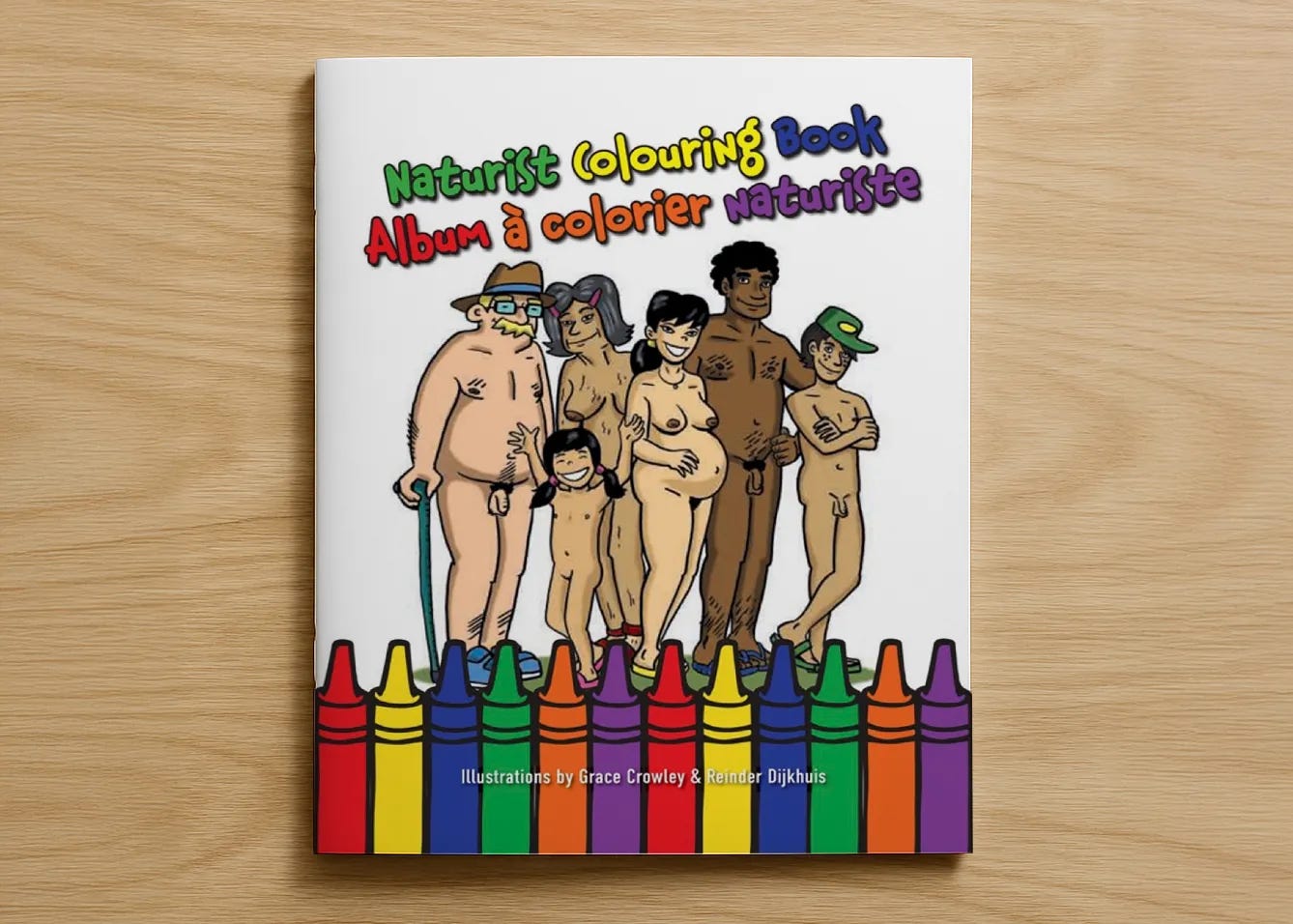Rejected as obscene: A children’s coloring book
PrintingCenterUSA’s refusal of a naturist children’s book reveals the very prejudice the project was created to confront
When International Naturist Federation president Stéphane Deschênes set out to produce a children’s coloring book, his goal was simple: give kids a fun, creative activity that also normalizes the human body in its natural state. The Naturist Coloring Book is filled with cheerful cartoon-style drawings of families picnicking, hiking, swimming, and playing games. It’s an educational project designed to support family naturism—the long-held belief that children can and should be part of naturist communities.
Just last week, Planet Nude published an interview with Stéphane about the origins and goals of the project. Even before that piece ran, I had been working with him to prepare a “Planet Nude edition” of the book for our Etsy gift shop. Stéphane’s version, available through the Bare Boutique at Bare Oaks in Canada, carries a bilingual English–French cover. Our edition simply removed the French, presenting the title in English only. It felt like a natural fit for Planet Nude: a playful, family-friendly book that embodies the values we aim to celebrate.
To get it into readers’ hands, I placed an order with PrintingCenterUSA, a Montana-based company that, after some pricing research, I chose to pursue this project with. The order was for 500 copies—a run that, after tax and shipping, came to over $1,000. For an independent operation like Planet Nude, that’s no small investment.
The company refused to print it.
The first refusal
On August 12, I received the company’s first reply. It cited their Adult Content Policy and explained:
“In reviewing your most recent order we have discovered some images that do not meet our guidelines… Tastefully done nudes and boudoir orders are OK for PrintingCenterUSA to produce. Nudes are normally printed if properly lit, posed and composed. They will not be printed if they are suggestive or sexually explicit in any way, or if there is any doubt as to the age of the models.”
The emphasis was theirs. That single line was bolded in their email, as if to underscore that this was the standard my project had failed to meet.
At least initially, the rejection was framed as a policy matter: that my book must have crossed into the territory of sexual activity, pornography, or suggestion. But that is a profound misunderstanding of what naturism is. The Naturist Coloring Book contains no sex, no pornography, no erotic suggestion. It is literally a set of line drawings showing families hiking, swimming, or sharing a meal.
Reading their refusal, my first reaction was simple: naturism is not sexual. They clearly don’t understand. Maybe if I explained it to them—patiently, with evidence and context—they would see the difference.
My appeal
In response, I laid out a detailed appeal, explaining that the Naturist Coloring Book in no way violated the standards they had cited.
The heart of my case was simple, and familiar to many naturists: nudity is not the same as sexuality. Too often, nudity is assumed to be inherently erotic or obscene, but that assumption is a cultural misconception, not a fact. Naturism is a recognized, legal, and internationally organized movement in which social nudity is viewed as non-sexual, wholesome, and yes, family-oriented. Families have practiced naturism openly and legally for more than a century in the U.S. and worldwide. This coloring book is simply an extension of that tradition.
I explained that the book was created as part of a naturist educational initiative supported by international naturist organizations that have advocated for social nudity for over seven decades. I highlighted that the book depicts fictional families in everyday activities without clothing. There is no sexual content, no pornographic intent, and nothing prurient. The inclusion of diverse ages, body types, and sizes was intentional, reinforcing the simple message that all bodies are natural and deserving of acceptance.
I addressed their three specific policy points directly. There is no sexual posing or erotic suggestion. These are stylized cartoon drawings, not photographs. No models were used, and no real people are depicted. As a work of illustrative fiction, there can be no doubt about age or identity. These are drawings, artistic and innocent, entirely consistent with the visual language of children’s educational materials.
Finally, I cited research: studies show that naturist participation is linked with improved body image, self-esteem, and life satisfaction in adults, and that children who encounter nudity in ordinary, non-sexual family contexts experience no general negative outcomes. U.S. case law has likewise affirmed that nudity alone is not obscene, as in Jenkins v. Georgia (418 U.S. 153, 1974).
Taken together, my appeal was simple: this coloring book does not cross the lines their own policy sets. It is wholesome, educational, and culturally important. By any reasonable interpretation, it should have been printed.
Moving the goalposts
After a week of silence, I followed up. A day later, on August 25th, I received a final reply. This time, the rationale had shifted.
The company was no longer claiming the Naturist Coloring Book violated specific prohibitions against sexual activity or pornography. Instead, they fell back on discretion, emphasizing that they “reserve the right to refuse to provide services or print any job involving nudity of any kind,” and that “The option to provide services for any project is at our sole discretion, and we reserve the right to refuse to provide services with or without cause.”
Again, all of the bold-text emphases above are theirs. The company had bolded these particular lines, shifting focus away from the original prohibitions on sexual activity or pornography and toward their discretionary power to reject “any job… with or without cause.”
Yet in the very same message, they insisted: “Our decision is policy-based and not a judgment on your intentions or message.” It is difficult to reconcile those two claims. What they call “policy” is in fact a declaration of judgment, resting not on objective rules but on taste.
And taste was, in fact, invoked explicitly. They were willing, they said, to consider “tastefully done nudes and boudoir work,” italicizing the words “tastefully done” (implying heavily that this project did not meet their level of taste).
There’s no accounting for taste, but there is a deeper irony in a system where a printer feels more comfortable reproducing “tasteful” boudoir than publishing line drawings that simply normalize the human body for children. In the end, the company heard the appeal but leaned instead on discretion. Logic and legality made no difference; what prevailed was taste—and the cultural reflex that still treats family naturism as suspect.
The irony
Deschênes told me in his interview that he anticipates controversy, even welcomes it. “The only way we seem to get attention these days is when there is a debate,” he said. “In the case of family naturism, that’s an easy one to win since the facts are on our side.”
He’s right. The facts are simple: families have practiced naturism openly and legally for over a century. Organized naturist associations have promoted family participation for decades. Research confirms the benefits. Courts have upheld its legality.
And yet, a mainstream U.S. printer decided that cartoon drawings of families at a picnic are more problematic than boudoir photography—that a children’s coloring book is beyond the pale.
PrintingCenterUSA is entitled to refuse business. But let’s be clear: this was not about compliance with policy. This was a cultural reflex—a fear of nudity so deep that even illustrated family recreation must be rejected. That reflex is exactly what the Naturist Coloring Book was created to confront. And in that sense, PrintingCenterUSA’s decision is almost too perfect. Their refusal proves the book’s point: that we still live in a society where the simple, non-sexual human body is treated as dangerous, obscene, or unprintable.
But there is a difference between good controversy and bad. A public debate allows us to confront misunderstanding head-on, to answer questions, and to win people over with facts. What happened here was something else entirely: a private act of judgment that stifles the conversation before it begins. That is not healthy controversy. That is discrimination, pure and simple.
And until that reflex is cured, projects like Stéphane’s coloring book will remain not just relevant, but essential. 🪐







This is no surprise. When I did my History of Club Orient book, I was going to do it traditional print and I have a relationship with two large printing houses, got a quote for the largest printer in the United States, I think, (former owner of the MN Timberwolves), they took my $5000 deposit sent the full pdf file and got a call two weeks later, they could not print it and refunded the money (even though they were printing MAXIM at the time. The other printer was a non-starter.......I ended up getting it printed at a short run printer in Indiana who was half the price as the company that does the "AANR Bulletin." A large bible they printed 100 years ago adorns their waiting room and most of the workers are dressed in Brethren/ Mennonite garb.......they have also done my Nude County USA and through my aide are doing a TNS book upcoming. This is one of those "I could have told you deals." Back in the day, Nudist magazine printers had to build up their own printing capabilities to do things.......things moderated in the 70s-90s but it may almost be as bad today
Look for a printer in France, Netherlands, Ukraine, Scandinavia.